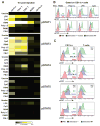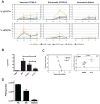Alternate mechanisms of initial pattern recognition drive differential immune responses to related poxviruses
- PMID: 20709294
- PMCID: PMC2940993
- DOI: 10.1016/j.chom.2010.07.008
Alternate mechanisms of initial pattern recognition drive differential immune responses to related poxviruses
Abstract
Vaccinia immunization was pivotal to successful smallpox eradication. However, the early immune responses that distinguish poxvirus immunization from pathogenic infection remain unknown. To address this, we developed a strategy to map the activation of key signaling networks in vivo and applied this approach to define and compare the earliest signaling events elicited by immunizing (vaccinia) and lethal (ectromelia) poxvirus infections in mice. Vaccinia induced rapid TLR2-dependent responses, leading to IL-6 production, which then initiated STAT3 signaling in dendritic and T cells. In contrast, ectromelia did not induce TLR2 activation, and profound mouse strain-dependent responses were observed. In resistant C57BL/6 mice, the STAT1 and STAT3 pathways were rapidly activated, whereas in susceptible BALB/c mice, IL-6-dependent STAT3 activation did not occur. These data link early immune signaling events to infection outcome and suggest that activation of different pattern-recognition receptors early after infection may be important in determining vaccine efficacy.
Copyright 2010 Elsevier Inc. All rights reserved.
Conflict of interest statement
Technologies associated with phospho-flow are licensed in part to BD Biosciences, and Dr. Garry P. Nolan is a consultant for BD Biosciences, a supplier of the reagents used in this report.
Figures




Comment in
-
STAT activation during viral infection in vivo: where's the interferon?Cell Host Microbe. 2010 Aug 19;8(2):132-5. doi: 10.1016/j.chom.2010.07.011. Cell Host Microbe. 2010. PMID: 20709291 Free PMC article.
Similar articles
-
Rapid expansion of CD8+ T cells in wild-type and type I interferon receptor-deficient mice correlates with protection after low-dose emergency immunization with modified vaccinia virus Ankara.J Virol. 2014 Sep;88(18):10946-57. doi: 10.1128/JVI.00945-14. Epub 2014 Jul 9. J Virol. 2014. PMID: 25008931 Free PMC article.
-
Comparable polyfunctionality of ectromelia virus- and vaccinia virus-specific murine T cells despite markedly different in vivo replication and pathogenicity.J Virol. 2012 Jul;86(13):7298-309. doi: 10.1128/JVI.00038-12. Epub 2012 Apr 24. J Virol. 2012. PMID: 22532670 Free PMC article.
-
A protein-based smallpox vaccine protects mice from vaccinia and ectromelia virus challenges when given as a prime and single boost.Vaccine. 2007 Jan 26;25(7):1214-24. doi: 10.1016/j.vaccine.2006.10.009. Epub 2006 Oct 17. Vaccine. 2007. PMID: 17098336 Free PMC article.
-
The Pathogenesis and Immunobiology of Mousepox.Adv Immunol. 2016;129:251-76. doi: 10.1016/bs.ai.2015.10.001. Epub 2015 Nov 21. Adv Immunol. 2016. PMID: 26791861 Review.
-
Genetic resistance to smallpox: lessons from mousepox.Novartis Found Symp. 2007;281:129-36; discussion 136-40, 208-9. doi: 10.1002/9780470062128.ch11. Novartis Found Symp. 2007. PMID: 17534070 Review.
Cited by
-
Engineering of double recombinant vaccinia virus with enhanced oncolytic potential for solid tumor virotherapy.Oncotarget. 2016 Nov 8;7(45):74171-74188. doi: 10.18632/oncotarget.12367. Oncotarget. 2016. PMID: 27708236 Free PMC article.
-
MyD88-dependent immunity to a natural model of vaccinia virus infection does not involve Toll-like receptor 2.J Virol. 2014 Mar;88(6):3557-67. doi: 10.1128/JVI.02776-13. Epub 2014 Jan 8. J Virol. 2014. PMID: 24403581 Free PMC article.
-
Control of early Theiler's murine encephalomyelitis virus replication in macrophages by interleukin-6 occurs in conjunction with STAT1 activation and nitric oxide production.J Virol. 2012 Oct;86(19):10841-51. doi: 10.1128/JVI.01402-12. Epub 2012 Jul 25. J Virol. 2012. PMID: 22837198 Free PMC article.
-
Single-cell mass cytometry for analysis of immune system functional states.Curr Opin Immunol. 2013 Aug;25(4):484-94. doi: 10.1016/j.coi.2013.07.004. Epub 2013 Aug 31. Curr Opin Immunol. 2013. PMID: 23999316 Free PMC article. Review.
-
Migratory Dendritic Cells, Group 1 Innate Lymphoid Cells, and Inflammatory Monocytes Collaborate to Recruit NK Cells to the Virus-Infected Lymph Node.Cell Rep. 2018 Jul 3;24(1):142-154. doi: 10.1016/j.celrep.2018.06.004. Cell Rep. 2018. PMID: 29972776 Free PMC article.
References
-
- Akira S, Uematsu S, Takeuchi O. Pathogen recognition and innate immunity. Cell. 2006;124:783–801. - PubMed
-
- Beutler B, Eidenschenk C, Crozat K, Imler JL, Takeuchi O, Hoffmann JA, Akira S. Genetic analysis of resistance to viral infection. Nat Rev Immunol. 2007;7:753–766. - PubMed
-
- Burdin N, Galibert L, Garrone P, Durand I, Banchereau J, Rousset F. Inability to produce IL-6 is a functional feature of human germinal center B lymphocytes. J Immunol. 1996;156:4107–4113. - PubMed
Publication types
MeSH terms
Substances
Grants and funding
LinkOut - more resources
Full Text Sources
Other Literature Sources
Research Materials
Miscellaneous

